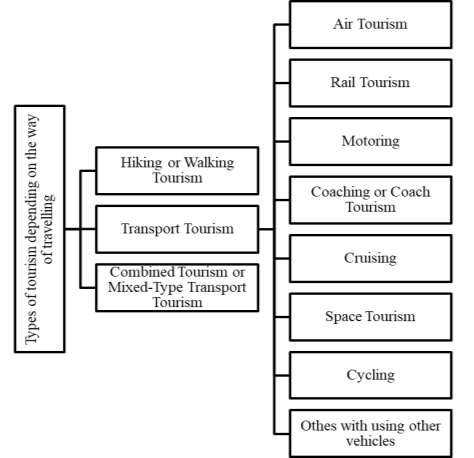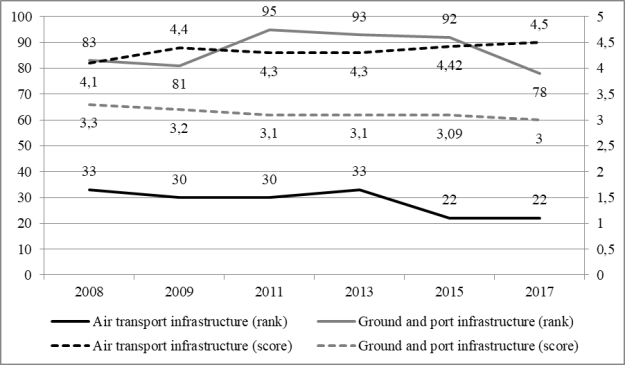Transport trips are considered to be an independent type of tourism, which makes the theme of tourism transport assurance especially relevant. The issue of transport is particularly actual for the Russian Federation, taking into account the size of the country and its water space. An analysis of The Travel and Tourism Competitiveness Reports gives an opportunity to look at transport state in dynamics.
Key words: tourism, transport, transport assurance, travel and tourism competitiveness
Transport is one of the most important components of the material base of the economy of each country. It is the engine of progress, and of course transport is an essential part of the tourism industry.
According to the Thesaurus on Tourism and Leisure Activities of World Tourism Organization (UNWTO), traditionally, there are distinguished three types of tourism, depending on the way of travelling: hiking or walking tourism, transport tourism and combined tourism or mixed-type transport tourism. Transport tourism is also divided on following types: air tourism, rail tourism, motoring, coaching or coach tourism, cruising, space tourism and others with using other vehicles (Picture 1) [1].

Fig. 1. Types of tourism depending on the way of travelling. Source: [1]
According to The Travel and Tourism Competitiveness Report 2017, which is published by World Economic Forum each two years, a share of travel and tourism industry in gross domestic product (GDP) of the Russian Federation is 1,5 % that is about US $17855,8 million [7]. The theme of transport tourism is particularly actual for our country, especially taking into account the territory Russia occupies (17125191 square kilometers, including the attached the Republic of Crimea and the city of federal significance Sevastopol in 2014), the extent of its coastline (37653 kilometers), and a share of country’s surface waters (12,4 % of the territory of the Russian Federation).
To appreciate transport assurance of tourism in Russia, let’s analyze The Travel and Tourism Competitiveness Reports from 2008 to 2017. It is a well-known fact that a structure of Travel and Tourism Competitiveness Index is based on 14 pillars, combined into 4 broad factors or subindexes of competitiveness starting from 2015. Draw your attention that in The Travel and Tourism Competitiveness Reports, published in 2008, 2009, 2011 and 2013 there were only three factors or categories: Travel and Tourism Regulatory Framework (5 pillars); Travel and Tourism Business Environment and Infrastructure (5 pillars); Travel and Tourism Human, Cultural, and Natural Resources (4 pillars). Furthermore, such pillars as Business Environment, ICT Readiness and International Openness were firstly published in only 2015.
Today these factors are: Enabling Environment (5 pillars), Travel and Tourism Policy and Enabling Conditions (4 pillars), Infrastructure (3 pillars), Natural and Cultural Resources (2 pillars) (Picture 2).

Fig. 2. Russian Federation. Travel and Tourism Competitiveness Pillars. Sources: [2], [3], [4], [5], [6], [7]
Referring to the theme of the article, it is necessary to devote attention to two pillars, comprised into the Infrastructure subindex. These are Air Transport Infrastructure and Ground and Port Infrastructure (Picture 3). These categories are characterized by several components. Air Transport Infrastructure [7]:
– Quality of air transport infrastructure;
– Available seat kilometers (domestic);
– Available seat kilometers (international) — this characteristic replaced “International Air Transport Network”, used from 2008 till 2013;
– Aircraft departures;
– Airport density;
– Number of operating airlines.
Ground and Port Infrastructure [7]:
– Quality of roads;
– Road density;
– Paved road density;
– Quality of railroad infrastructure;
– Railroad density;
– Quality of port infrastructure;
– Ground transport efficiency.
In earlier editions there were only 5 characteristics of Ground and Port Infrastructure: 1) quality of roads; 2) quality of railroad infrastructure; 3) quality of port infrastructure; 4) quality of domestic transport network; 5) road density.

Fig. 3. Rank and Index of Travel and Tourism Competitiveness of Russia through transport assurance. Sources: [2], [3], [4], [5], [6], [7]
It can be seen from the graph that the indicators of Air Transport Infrastructure have quite positive trends from year to year, according to the WEF’s experts (Picture 3). The situation with Ground and Port Infrastructure is not so positive. On the contrary, the majority of criteria are inferior in 2017. For example, the quality of roads dropped by 15 points from 106 in 2008 to 121 in 2017. The indicator of the road density also deteriorated in 2017 in comparison with the same indicator in 2008 (111 rank in 2008, 118 — in 2017). The index of port infrastructure quality remained unchanged (the 72rd of 136). And it is vivid evidence that nothing was undertaking or it was not enough for the development of river tourism, cruising and other types of tourism using the potential of the Russian territorial and coastal water space. The only characteristic of the Ground and Port Infrastructure, that has improved its position in ranking, is the quality of railroad infrastructure. It rose from 29th in 2008 to 25th in 2017.
Thus, coming to the conclusion, it can be noted, in spite of the fact that the Russian Federation has a great potential for transport tourism development, this issue is devoted insufficient attention at the government (state) level. Such factors as constantly rising prices for fuel and quality of Russian roads harm the development of motoring, coaching and cycling on the territory of the Russian Federation. The quality of port infrastructure blemishes river tourism and cruising. The price for air travel and the duration of railway trips from the eastern part of Russia to the west and back and vice versa negatively affect the development of domestic air and rail tourism, respectively.
References:
- Thesaurus on Tourism and Leisure Activities. Madrid: WTO, 2001.
- The Travel & Tourism Competitiveness Report 2008. Balancing Economic Development and Environmental Sustainability. Geneva: WEF, 2008.
- The Travel & Tourism Competitiveness Report 2009. Managing in a Time of Turbulence. Geneva: WEF, 2009.
- The Travel & Tourism Competitiveness Report 2011. Beyond the Downturn. Geneva: WEF, 2011.
- The Travel & Tourism Competitiveness Report 2013. Reducing Barriers to Economic Growth and Job Creation. Geneva: WEF, 2013.
- The Travel & Tourism Competitiveness Report 2015. Growth through Shocks. Geneva: WEF, 2015.
- The Travel & Tourism Competitiveness Report 2017. Paving the Way for a More Sustainable and Inclusive Future. Geneva: WEF, 2017.







